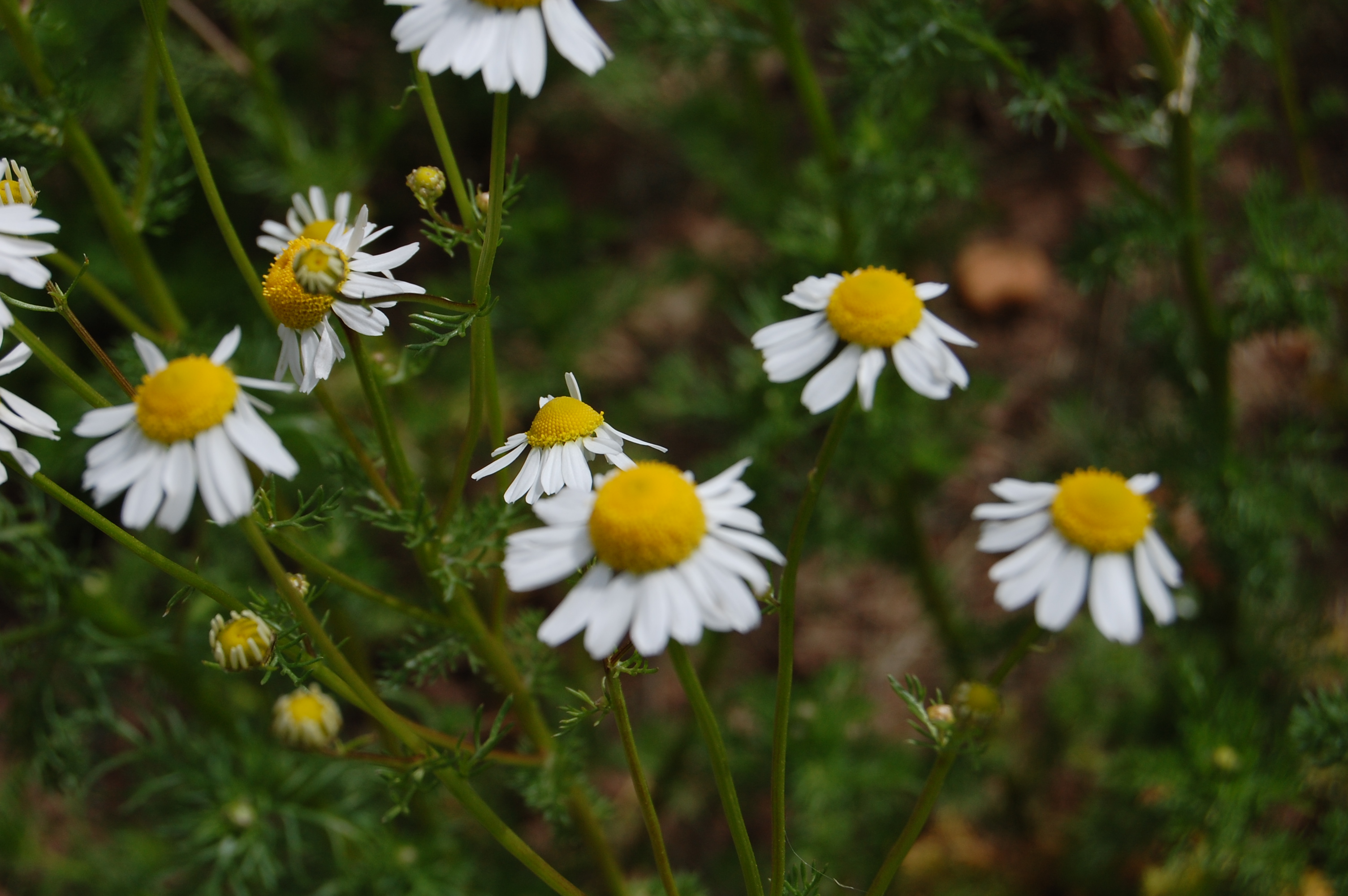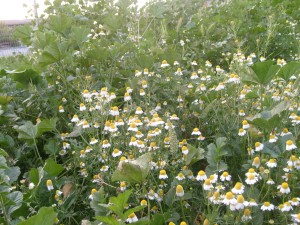A soothing cup of chamomile tea is a perfect nightcap. You can make it from either of the two types of chamomile, German or Roman. Most people grow German chamomile (Matricaria chamomilla), especially in their vegetable gardens where it repels the dreaded cucumber beetle. It is also known as The Plant Doctor because anything planted near it will grow better.
The name chamomile derives from Greek and means earth apple, a reference to the apple scent of the flowers. German chamomile is native to Europe and temperate zones in Asia. It was introduced in North America and Australia by European colonists. In Europe, it has been in use for centuries.
German chamomile is an annual herb that grows to a height of 24 to 36 inches tall. The plants tend to be tall and spindly, often falling over in the garden if not supported by surrounding plants. It is not usually used as a bedding plant. It prefers full sun, but will tolerate a little shade. Grow your German chamomile in sandy, well-drained soil that is not too rich. Like most herbs, it does not require a lot of fertilizer. Water your plants regularly. Don’t let them dry out.
German chamomile is easy to grow from seed. You can start your seeds indoors 6 weeks before your last frost, direct sow them in your garden in the spring or even sow them in your garden in the fall for spring germination. No matter when you sow your seeds, make sure that you are sowing them on the surface of the soil. Gently press them down so that they have good contact with the soil but do not cover them. The seeds need light to germinate. Germination should occur within 7 to 14 days. If started indoors, you can transplant your seedlings outdoors after your last frost.
Chamomile tea is made from the flower of the chamomile plant. Some people use the leaves also but they can be bitter. When harvesting most herb flowers, you harvest them before they are fully open. In the case of chamomile, you want to harvest the flowers when they are fully open. Don’t let them fool you! Even though they look like daisies, the flowers aren’t fully open until the petals are pointing downwards. Harvesting the flowers is easy. Use your garden shears and shear them off of the top of the plants. Be sure to leave a few flowers to make seeds for next year. German chamomile readily self-sows in your garden, but it is not invasive.
You can dry your chamomile flowers using one of several methods. You can spread them in a single layer on an old window screen in a dark, dry spot until they are dry, use a food dehydrator, or even dry them in your oven. Simply place them on parchment paper covered cookie sheets in a 100°F-110°F oven for 2 to 3 hours. Then put them in an air tight container and store them in a cool, dark place with no sun exposure.
To make chamomile tea, bring your water to a boil and transfer it to a non-metal teapot. Add 1 tablespoon of the dried flowers to the pot for each cup of water, plus an extra 1 tablespoon “for the pot.” Don’t forget to use more chamomile if making ice tea to allow for the extra water from the melting ice cubes.
If you are going to steep it in a cup, be sure to cover the cup while it is steeping. This prevents the oils which give it the flavor and soothing effect from evaporating. Steep it for five to 10 minutes, strain out the flowers and enjoy!
A word of caution for those of you who suffer from hay fever. Chamomile is related to ragweed, so you may have the same reaction to it. You should also avoid chamomile if you are pregnant. It can cause contractions which could result in miscarriage.



13 Comments on “German Chamomile”
Pingback: Wintersowing Herbs - Advice From The Herb Lady
What part do i save for planting next year
You should allow the flowers to go to seed and save the seed for planting next year.
Several years ago I bought some dried German Chamomile in Devon. They were so big that you just needed one flower to make a cuppa. We were told they were double petaled. Any idea what it was. It tasted slightly sweeter than the chamomile we were used to and I haven’t been able to source again. Any ideas?
I am not familiar with any large flowered chamomile type plants. The true chamomiles all have small flowers.
Do you know what part of the flower is used to distill German Chamomile oil? Is it the whole flower, or just the yellow center?
The yellow centers contain the oils that give chamomile its distinctive flavor and properties.
Can you tell me if I can dig up my German chamomile and relocate them? My neighbor is having underground sprinkler issues and will be digging up their yard, my plants are on the boarder and will be destroyed. this will be done within the next week. They are already very tall and very full with beautiful full flowers on them.
Harvest the flowers and then try transplanting the remaining plants. They may or may not survive and produce more flowers. German chamomile is an annual so I would harvest the flowers this year and then start over next year.
Are you aware that the title portion of the first page prints badly – about 3 layers of type.
My website is not designed to be printed.
When do the flowers bloom
It blooms from early summer until frost kills the plants, so depending on where you live you can expect blossoms starting in May.